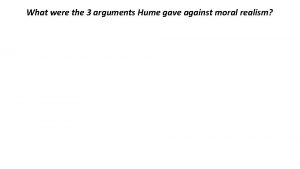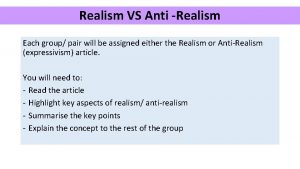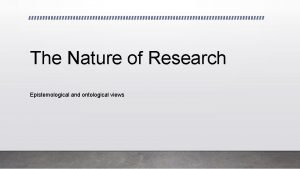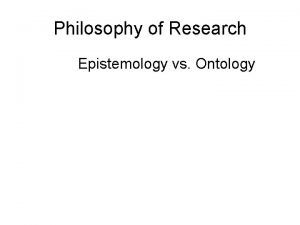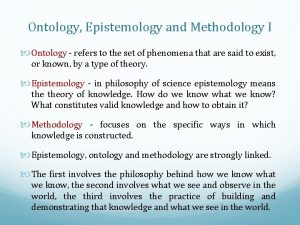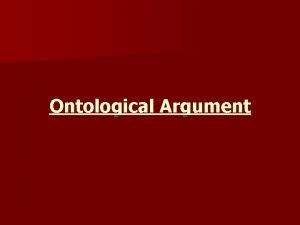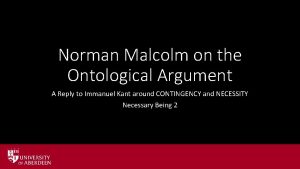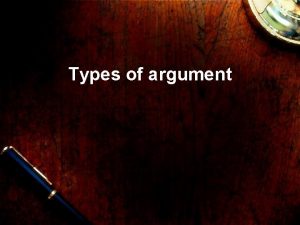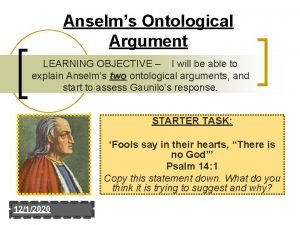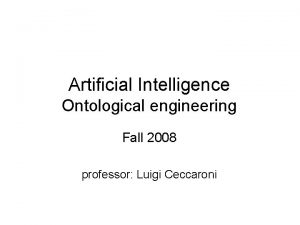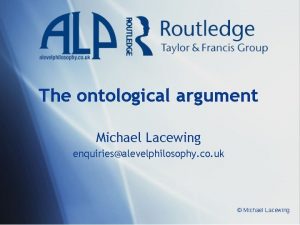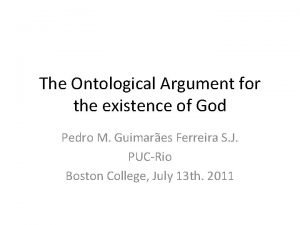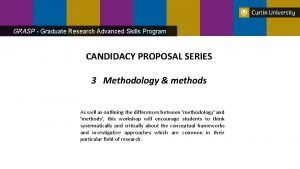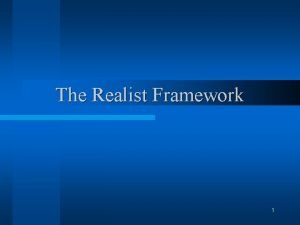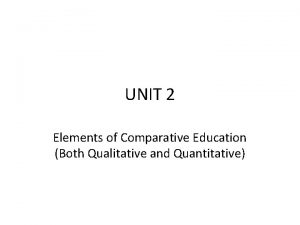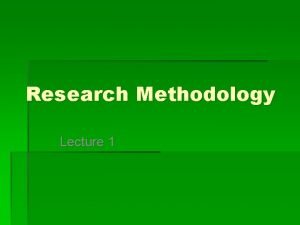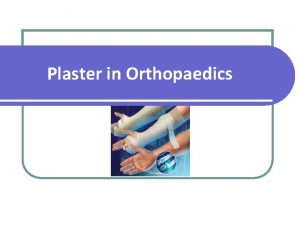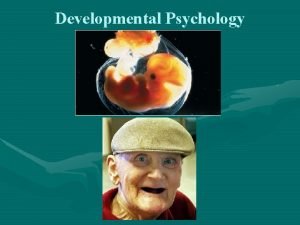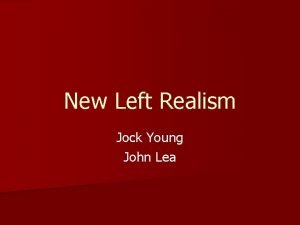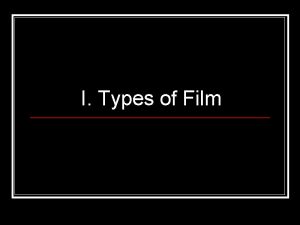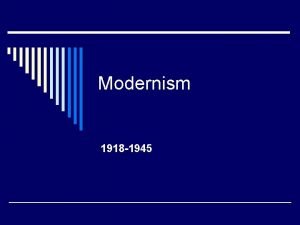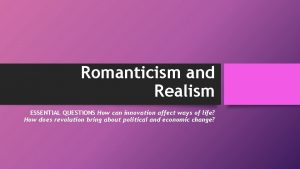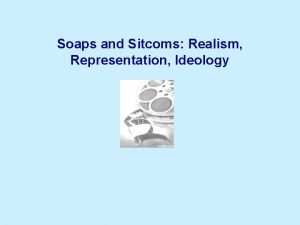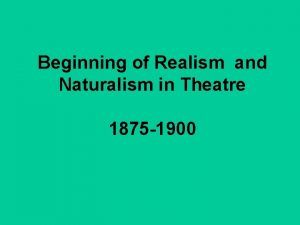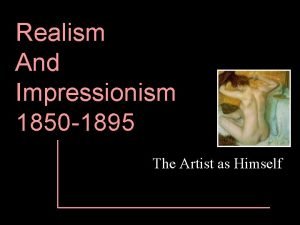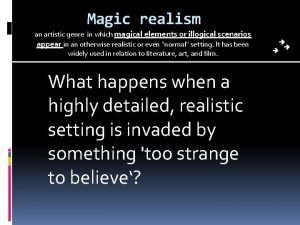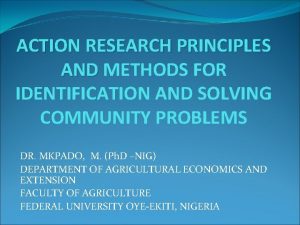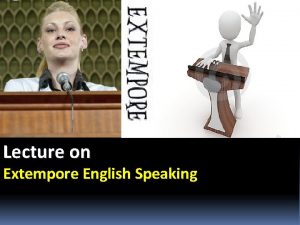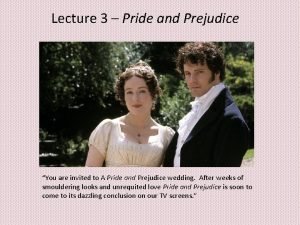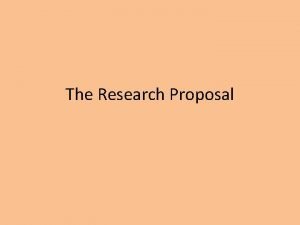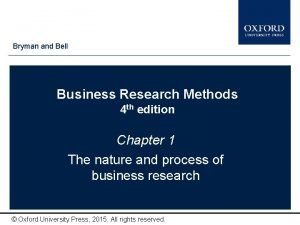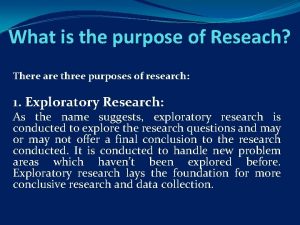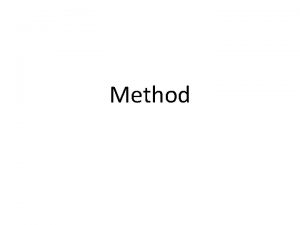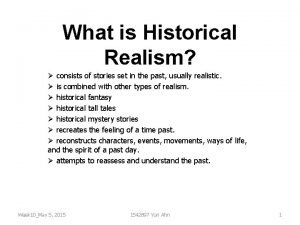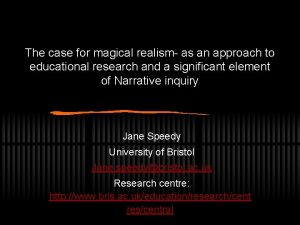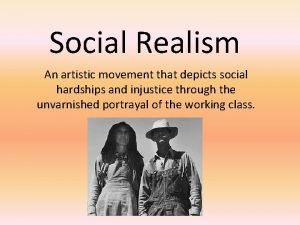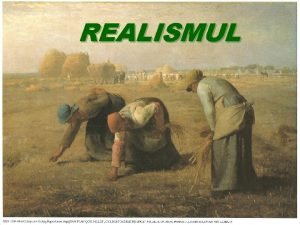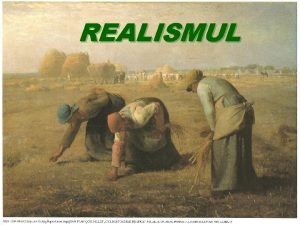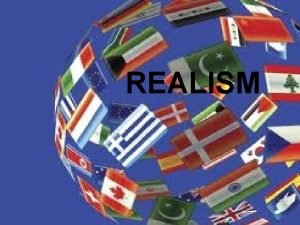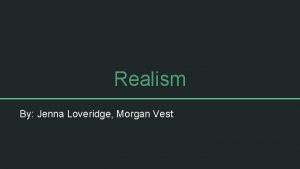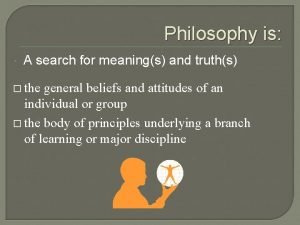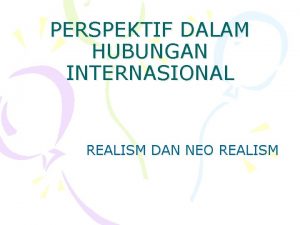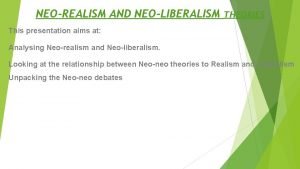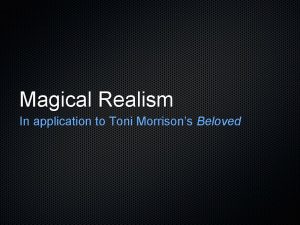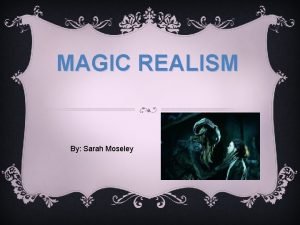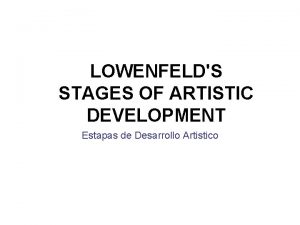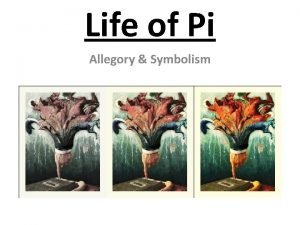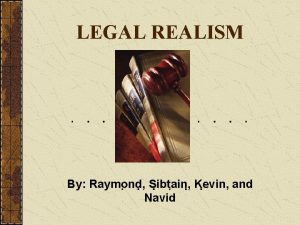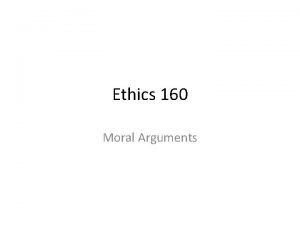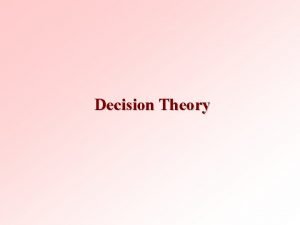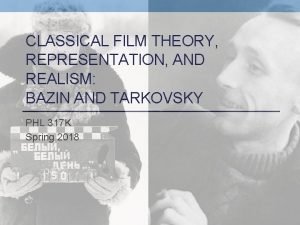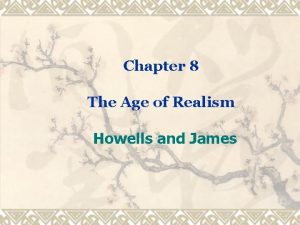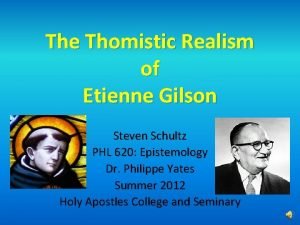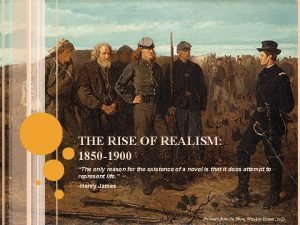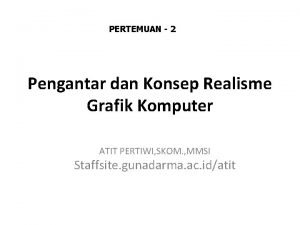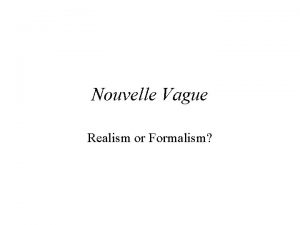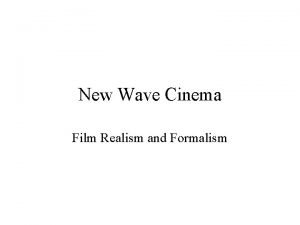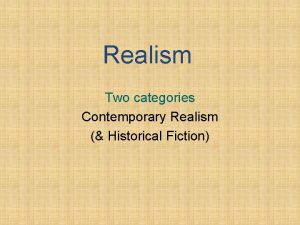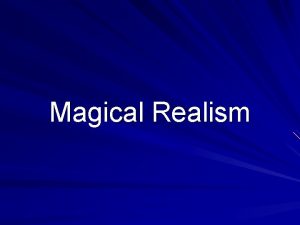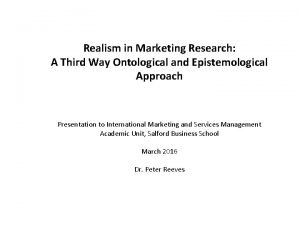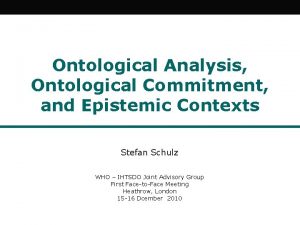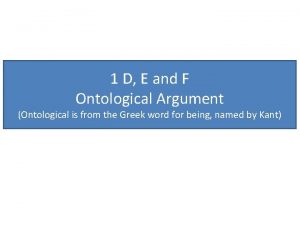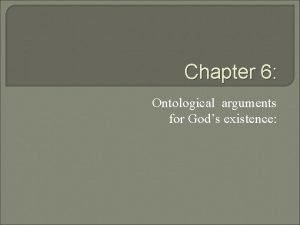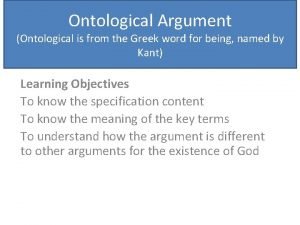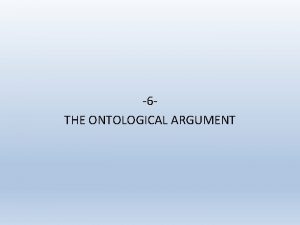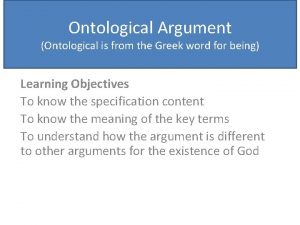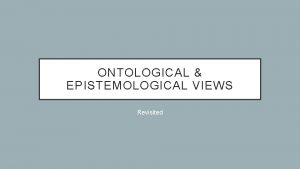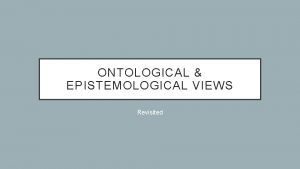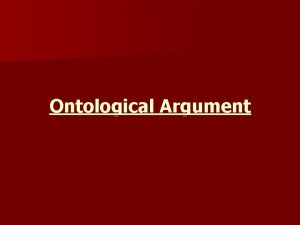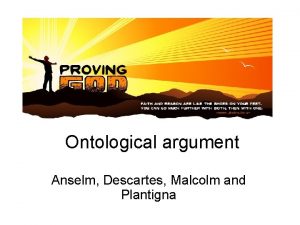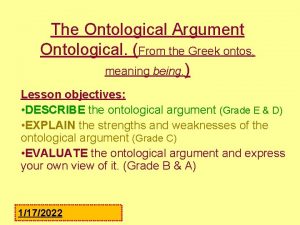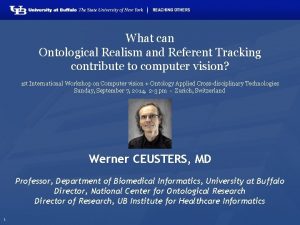Ontological Realism in Research Principles and Application Lecture





















































































































































- Slides: 149

Ontological Realism in Research: Principles and Application. Lecture for BMI 504: Data Analysis, and Research Methods in Biomedical Informatics April 6, 2016 University at Buffalo, Medical Campus Werner CEUSTERS, MD Ontology Research Group, Center of Excellence in Bioinformatics and Life Sciences, UB Institute for Healthcare Informatics, Departments of Biomedical Informatics and Psychiatry, University at Buffalo, NY, USA

Lecture overview • Introduction to philosophical basis of research • Special focus on Ontological Realism • Discussion of issues in biomedical informatics • • Statistical data analysis Maintaining a distinction between data and what data are about Information models Data management The notion of ‘biomarkers’ ‘Mental disease’ Extraterrestrial research

Philosophical basis

Four notions of ‘ontology’ as a study (O 1) the study of ontological commitment, i. e. what we or others are committed to, (O 2) the study of what there is, (O 3) the study of the most general features of what there is, and how the things there are relate to each other in the metaphysically most general ways, (O 4) the study of meta-ontology, i. e. saying what task it is that the discipline of ontology should aim to accomplish, if any, how the questions it aims to answer should be understood, and with what methodology they can be answered. http: //plato. stanford. edu/entries/logic-ontology/#Dif. Con. Ont

The basis of Ontological Realism (O. R. ) 1. There is an external reality which is ‘objectively’ the way it is; 2. That reality is accessible to us; 3. We build in our brains cognitive representations of reality; 4. We communicate with others about what is there, and what we believe there is there. Smith B, Kusnierczyk W, Schober D, Ceusters W. Towards a Reference Terminology for Ontology Research and Development in the Biomedical Domain. Proceedings of KR-MED 2006, Biomedical Ontology in Action, November 8, 2006, Baltimore MD, USA

L 3 Linguistic representations about (L 1 -), (L 2) or (L 3) Re pr L 2 Beliefs about (1) ese nt at ion s First Order Reality L 16 Entities (particular or generic) with objective existence which are not about anything

Definition of ‘research’ 1. careful or diligent search 2. studious inquiry or examination; especially : investigation or experimentation aimed at - the discovery and interpretation of facts, - revision of accepted theories or laws in the light of new facts, - or practical application of such new or revised theories or laws 3. the collecting of information about a particular subject http: //www. merriam-webster. com/dictionary/research

Definition of ‘research’ Keywords? 1. careful or diligent search 2. studious inquiry or examination; especially : investigation or experimentation aimed at - the discovery and interpretation of facts, - revision of accepted theories or laws in the light of new facts, - or practical application of such new or revised theories or laws 3. the collecting of information about a particular subject http: //www. merriam-webster. com/dictionary/research

Definition of ‘research’ keywords 1. careful or diligent search 2. studious inquiry or examination; especially : investigation or experimentation aimed at - the discovery and interpretation of facts, - revision of accepted theories or laws in the light of new facts, - or practical application of such new or revised theories or laws 3. the collecting of information about a particular subject http: //www. merriam-webster. com/dictionary/research

Keywords in research • Discovery: • D 1: there is something existing which is prior to our knowing about its existence. • D 2: There is something we come to know we didn’t know before

Keywords in research • Discovery: • D 1: there is something existing which is prior to our knowing about it. • D 2: There is something we come to know we didn’t know before • Facts: • F 1: I am currently teaching • F 2: ‘I am currently teaching’ • F 3: 2 + 2 = 4

Keywords in research • Discovery: • D 1: there is something existing which is prior to our knowing about it. • D 2: There is something we come to know we didn’t know before • Facts: • F 1: I am currently teaching D 1 L 1 • F 2: ‘I am currently teaching’ D 1 & D 2 L 3/L 1 • F 3: 2 + 2 = 4 D 2 L 3

Keywords in research • Discovery: • D 1: there is something existing which is prior to our knowing about it. • D 2: There is something we come to know we didn’t know before • Facts: • F 1: I am currently teaching D 1 L 1 • F 2: ‘I am currently teaching’ D 1 & D 2 L 3/L 1 • F 3: 2 + 2 = 4 D 2 L 3 • Interpretation: • F 1 is truth-maker for F 2 when F 2 is uttered when F 1 is happening • F 1 is truth-maker for ‘I was teaching’ when uttered after F 1 ceased to be the case. • What is the truth-maker for F 3?

Four notions of Logic (L 1) the study of artificial formal languages e. g. properties of predicate logic studied in model theory (L 2) the study of formally valid inferences and logical consequence e. g. IF A then B: A, therefor: B not B, therefor: not A (L 3) the study of logical truths the most general truths, ones that are contained in any other body of truths that any other science aims to describe (L 4) the study of the general features, or form, of judgements (Kant)

Definition of ‘science’ 3 a : knowledge or a system of knowledge covering general truths or the operation of general laws especially as obtained and tested through scientific method 3 b : such knowledge or such a system of knowledge concerned with the physical world and its phenomena: natural science http: //www. merriam-webster. com/dictionary/science

Definition of ‘science’ 3 a : knowledge or a system of knowledge covering general truths or the operation of general laws especially as obtained and tested through scientific method 3 b : such knowledge or such a system of knowledge concerned with the physical world and its phenomena: natural science http: //www. merriam-webster. com/dictionary/science

The Scientific Method • principles and procedures for the systematic pursuit of knowledge involving the recognition and formulation of a problem, the collection of data through observation and experiment, and the formulation and testing of hypotheses

The Scientific Method • principles and procedures for the systematic pursuit of knowledge involving the recognition and formulation of a problem, the collection of data through observation and experiment, and the formulation and testing of hypotheses http: //www. merriamwebster. com/dictionary/scientific%20 method

By Archon. Magnus - Own work, CC BY-SA 4. 0, https: //commons. wikimedia. org/w/index. php? curid=42164616

Quantitative research In natural sciences and social sciences, quantitative research is the systematic empirical investigation of observable phenomena via statistical, mathematical or computational techniques. https: //en. wikipedia. org/wiki/Quantitative_research Qualitative Research is primarily exploratory research used to gain an understanding of underlying reasons, opinions, and motivations. It provides insights into the problem or helps to develop ideas or hypotheses for potential http: //www. snapsurveys. com/blog/what-is-the-difference-betweenquantitative research. qualitative-research-and-quantitative-research/

Qualitative vs. quantitative research Qualitative research emphasizes the importance of looking at variables in the natural setting in which they are found. Interaction between variables is important. Detailed data is gathered through open ended questions that provide direct quotations. The interviewer is an integral part of the investigation (Jacob, 1988). This differs from quantitative research which attempts to gather data by objective methods to provide information about relations, comparisons, and predictions and attempts to remove the investigator from the investigation (Smith, 1983). http: //www. okstate. edu/ag/agedcm 4 h/academic/aged 5980 a/5980/newpage 21. htm

Characteristics of qualitative research Purpose Reality Understanding - Seeks to understand people’s interpretations. Dynamic - Reality changes with changes in people’s perceptions. Viewpoint Insider - Reality is what people perceive it to be. Values Value bound - Values will have an impact and should be understood and taken into account when conducting and reporting research. Focus Holistic - A total or complete picture is sought. Orientation Discovery - Theories and hypotheses are evolved from data as collected. Data Subjective - Data are perceptions of the people in the environment. Instrumentation Human - The human person is the primary collection instrument. Conditions Naturalistic - Investigations are conducted under natural conditions. Results Valid - The focus is on design and procedures to gain "real, " "rich, " and "deep" data. http: //www. okstate. edu/ag/agedcm 4 h/academic/aged 5980 a/5980/newpage 21. htm

Realism Generic Realism (on some subject matter): a, b, and c and so on exist, and the fact that they exist and have properties such as Fness, G-ness, and H-ness is (apart from mundane empirical dependencies of the sort sometimes encountered in everyday life) independent of anyone's beliefs, linguistic practices, conceptual schemes, and so on. http: //plato. stanford. edu/entries/realism/

Scientific Realism Three dimensions: • Metaphysically: • Semantically: • Epistemologically: http: //plato. stanford. edu/entries/scientific-realism/#Wha. Sci. Rea

Relevant disciplines and theories • Ontology • by some philosophers taken to be synonymous with ‘metaphysics’ while others draw distinctions in many distinct ways but almost agreeing on the following classification: • metaphysics • general metaphysics • ontology • special metaphysics • ‘epistemology’: • ‘terminology’ (as part of ‘semantics’):

Relevant disciplines and theories • Ontology (no plural) is the study of what entities exist and how they relate to each other; • by some philosophers taken to be synonymous with ‘metaphysics’ while others draw distinctions in many distinct ways but almost agreeing on the following classification: • metaphysics studies ‘how is the world? ’ • general metaphysics studies general principles and ‘laws’ about the world • ontology studies what type of entities exist in the world • special metaphysics focuses on specific principles and entities • ‘epistemology’: the study of how we can come to know about what exists. • ‘terminology’ (as part of ‘semantics’): the study of what terms mean and how to name things.

Distinct questions. What type are they of? Terminological: • what does ‘pain’ mean ? Metaphysical: • what have all pains in common in virtue of which they are pains? Ontological: • what type of entity is pain? Onto-terminological: • what, if anything at all, does ‘pain’ denote? Epistemological: • how can we find out whether something is pain? 27

Scientific Realism Three dimensions: • Metaphysically: commits to the mind-independent existence of the world investigated by the sciences. • Semantically: commits to a literal interpretation of scientific claims about the world. Claims about scientific entities, processes, properties, and relations, whether they be observable or unobservable, should be construed literally as having truth values, whether true or false. • Epistemologically: commits to the idea that theoretical claims (interpreted literally as describing a mindindependent reality) constitute knowledge of the world. http: //plato. stanford. edu/entries/scientific-realism/#Wha. Sci. Rea

Scientific Realism Our best scientific theories give true or approximately true descriptions of observable and unobservable aspects of a mind-independent world. http: //plato. stanford. edu/entries/scientific-realism/#Wha. Sci. Rea

Scientific Objectivity (1) • Objectivity as Faithfulness to Facts • Objectivity as Absence of Normative Commitments and the Value-Free Ideal • Objectivity as Freedom from Personal Biases • Measurement and Quantification • Inductive and Statistical Inference

Scientific Objectivity (2) Science is objective in that, or to the extent that: • its products—theories, laws, experimental results and observations—constitute accurate representations of the external world. The products of science are not tainted by human desires, goals, capabilities or experience. product objectivity • the processes and methods that characterize it neither depend on contingent social and ethical values, nor on the individual bias of a scientist process objectivity. http: //plato. stanford. edu/entries/scientific-objectivity

The view from nowhere There are two kinds of qualities: ones that vary with the perspective one has or takes, and ones that remain constant through changes of perspective. The latter are the objective properties. http: //plato. stanford. edu/entries/scientific-objectivity

The view from nowhere Nagel’s 3 -step conception: 1. realize (or postulate) that our perceptions are caused by the actions of things on us, through their effects on our bodies. 2. realize (or postulate) that since the same properties that cause perceptions in us also have effects on other things and can exist without causing any perceptions at all, their true nature must be detachable from their perspectival appearance and need not resemble it. 3. form a conception of that “true nature” independently of any perspective. http: //plato. stanford. edu/entries/scientific-objectivity Nagel, T. , 1986, The View From Nowhere, New York, NY: Oxford University Press.

Impact of value(s) on science 1. the choice of a scientific research problem; 2. the gathering of evidence in relation to the problem; 3. the acceptance of a scientific hypothesis or theory as an adequate answer to the problem on the basis of the evidence; 4. the proliferation and application of scientific research results. (Weber 1917 [1988]). http: //plato. stanford. edu/entries/scientific-objectivity

Value types • Scientific values: • Accuracy, simplicity, … • Epistemic (or cognitive) values: • predictive accuracy, scope, unification, explanatory power, coherence with other accepted theories, … • contextual (non-cognitive) values: • moral, personal, social, political and cultural values such as pleasure, justice and equality, conservation of the natural environment, diversity, … http: //plato. stanford. edu/entries/scientific-objectivity

Three theses • Value-Free Ideal (VFI): • Scientists should strive to minimize the influence of contextual values on scientific reasoning, e. g. , in gathering evidence and assessing/accepting scientific theories. • scientific objectivity is characterized by absence of contextual values and by exclusive commitment to epistemic values in scientific reasoning • Value-Neutrality Thesis (VNT): • Scientists can—at least in principle—gather evidence and assess/accept theories without making contextual value judgments. • Value-Laden Thesis (VLT): • Scientists cannot gather evidence and assess/accept theories without making contextual value judgments. http: //plato. stanford. edu/entries/scientific-objectivity

Inductive and Statistical Inference No statistical theory of evidence manages to eliminate all sources of personal bias and idiosyncrasy. • The Bayesian is honest about it: subjective assumptions are ineliminable from scientific reasoning. Bayesian inductive logic tells you how to change your own attitudes as soon as you encounter evidence. • The likelihoodist has perhaps the “purest” model of objective statistical evidence, but also the one with the most restricted scope. • The frequentist conception based on p-values still dominates statistical practice, but it suffers from several conceptual drawbacks, and in particular the misleading impression of objectivity. http: //plato. stanford. edu/entries/scientific-objectivity

Evidence-based medicine • Evidence-based medicine de-emphasizes intuition, unsystematic clinical experience, and pathophysiological rationale as sufficient grounds for clinical decision making and stresses the examination of evidence from clinical research. • ‘Evidence’ = analyses of the results of randomized controlled trials (RCTs) which attempt to eliminate selection bias. • Judgment still required to assess the extent to which a patient is similar to the study subjects http: //plato. stanford. edu/entries/scientific-objectivity

Statistical data analysis

Clinical data registration and use Register in EHR observation & measurement research Δ= outcome application

An EHR data collection

Standard approach in data analysis Characteristics Cases ch 1 ch 2 ch 3 ch 4 ch 5 ch 6 . . . case 1 case 2 case 3 case 4 case 5 case 6 . . . phenotypic genotypic treatment outcome …

Standard approach in data analysis (1) Characteristics Cases ch 1 ch 2 ch 3 ch 4 ch 5 ch 6 . . . case 1 case 2 case 3 case 4 case 5 case 6 . . . finding correlations phenotypic genotypic treatment outcome …

Standard approach in data analysis (2) Characteristics Cases ch 1 case 2 case 3 case 4 case 5 case 6 . . . ch 2 ch 3 ch 4 ch 5 ch 6 . . . { finding correlations therefore phenotypic expectation genotypic treatment outcome …

Standard approach in data analysis (3) Characteristics Cases ch 1 case 2 case 3 case 4 case 5 case 6 . . . ch 2 ch 3 ch 4 ch 5 ch 6 . . . generalization ? { finding correlations therefore phenotypic expectation genotypic treatment outcome …

Is it that easy? A clinician runs a query over his electronic health record system to create two groups of patients: • those who have higher average blood pressures in winter than in summer, and • those with no seasonal difference in average blood pressure. He then checks both groups for their drinking habits and finds that the group with higher winter blood pressures has a higher percentage of rum drinkers than the other group. Which of the following conclusions can he make? 1. 2. 3. 4. 5. high blood pressure causes people to drunk rum in winter; rum causes people to have higher blood pressure, both in winter and summer; cold weather makes people drink more rum, and also increases their blood pressure; all of the above are valid conclusions; none of the above are valid conclusions.

Correlation vs. Causality A clinician runs a query over his electronic health record system to create two groups of patients: • those who have higher average blood pressures in winter than in summer, and • those with no seasonal difference in average blood pressure. He then checks both groups for their drinking habits and finds that the group with higher winter blood pressures has a higher percentage of rum drinkers than the other group. Which of the following conclusions can he make? 1. 2. 3. 4. 5. high blood pressure causes people to drunk rum in winter; rum causes people to have higher blood pressure, both in winter and summer; cold weather makes people drink more rum, and also increases their blood pressure; all of the above are valid conclusions; none of the above are valid conclusions.

Question There is a test for a disease for which: • the rate of false negatives (negative results in cases where the disease is present) is zero, and • the rate of false positives (positive results in cases where the disease is absent) is one in ten (that is, disease-free individuals test positive 10% of the time). If one tests positive, what are the chances that one has the disease?

Question There is a test for a disease for which: • the rate of false negatives (negative results in cases where the disease is present) is zero, and • the rate of false positives (positive results in cases where the disease is absent) is one in ten (that is, disease-free individuals test positive 10% of the time). If one tests positive, what are the chances that one has the disease? 90% ?

Base rate fallacy There is a test for a disease for which: • the rate of false negatives is zero, and • the rate of false positives is one in ten. If one tests positive, what are the chances that one has the disease? The actual probability depends on some further, crucial information: the base rate of the disease in the population (the proportion of people having it). The lower the incidence of the disease at large, the lower the probability that a positive result signals the presence of the disease. http: //plato. stanford. edu/entries/scientific-realism/#Wha. Sci. Rea

Pitfalls in statistics Three broad categories: • Sources of bias. • These are conditions or circumstances which affect the external validity of statistical results. • Errors in methodology, • which can lead to inaccurate or invalid results. • Interpretation errors, • misapplication of statistical results to real world issues.

Example: confounding in epidemiology Confounders are: not part of the real association between exposure and disease, • predictors of disease, • unequally distributed between exposure groups. • Example: grey hair • • • take from the street the first 100 people you encounter with grey hair and the first 100 that don’t have grey hair; check them for heart disease; you will very likely find that there are significantly more people in the grey hair group that have heart disease than in the other group because both grey hair and heart disease are more prevalent in elderly; therefore (? ): grey hair causes heart disease (or the other way round? )

Some strategies to reduce confounding • randomization (distribute - known and measurable confounders between study groups) • restriction (restrict entry to study of individuals with confounding factors • risks: introduce bias • matching, stratification, adjustment, … • check your course in medical statistics, • if you didn’t take one: shame on you.

However !

Maintaining a distinction between data and what data are about

Correlation with reality • What type of relationship is there between data items and the part of reality they are obtained from? • What, if anything at all, do variable names in header rows correspond to? • Do correlations between data items mimic the relationships between the entities in reality the data items are obtained from?

A non-trivial relation Referents References 57

For instance: source and impact of changes Are differences in data about the same entities in reality at different points in time due to: • changes in first-order reality ? • changes in our understanding of reality ? • inaccurate observations ? • differences in perspectives ? • registration mistakes ? Ceusters W, Smith B. A Realism-Based Approach to the Evolution of Biomedical Ontologies. AMIA 2006 Proceedings, Washington DC, 2006; : 121 -125. http: //www. referent-tracking. com/RTU/sendfile/? file=Ceusters. AMIA 2006 FINAL. pdf

What makes it non-trivial? Referents are (meta-) physically the way they are, • relate to each other in an objective way, • follow laws of nature. • Window on reality restricted by: − what is physically and technically observable, − fit between what is measured and what we think is measured, − fit between established knowledge and laws of nature. References follow, ideally, the syntacticsemantic conventions of some representation language, • are restricted by the expressivity of that language, • to be interpreted correctly, reference collections need external documentation. •

Satellite view

Map

Map overlay

Main data reality views Nominalism: • there are no generic entities in reality: there is no ‘personhood’, there are only individual persons. Conceptualism: • generalizations are in our minds. ‘personhood’ is a concept construed in our mind that allows us to reason about persons without any particular person in mind. Realism: • generic entities do exist and are called ‘universals’. Each particular person is an instance of the universal we call ‘person’.

Main data reality views Nominalism: • there are no generic entities in reality: there is no ‘personhood’, there are only individual persons. Conceptualism: mainstream approach • generalizations are in our minds. ‘personhood’ is a concept construed in our mind that allows us to reason about persons without any particular person in mind. Realism: our approach • generic entities do exist and are called ‘universals’. Each particular person is an instance of the universal we call ‘person’.

Conceptualism versus Ontological Realism First order reality universal concept term referent Conceptualism representational unit particular Ontological Realism

What is out there … (… we want/need to deal with)? portions of reality ? relations configurations participation universals entities me participating in my life ? particulars continuants me organism occurrents my life

The essential pieces dependent continuant material object t history me … at t spatial region instance. Of t participant. Of at t some quality spacetime region t occupies my life my 4 D STR projects. On at t located-in at t some spatial region temporal region projects. On some temporal region

Ambiguities: are assertions about particulars or types? ‘Persistent idiopathic facial pain (PIFP)’ = ‘persistent facial pain with varying presentations …’ persistent facial pain types presentation type 1 t 1 presentation type 3 t 2 t 1 t 2 t 3 particulars presentation type 2 t 1 t 2 t 3 my pain t 1 t 3 t 2 t 1 t 3 her pain t 2 t 3 his pain

Ambiguities: are assertions about particulars or types? ‘Persistent idiopathic facial pain (PIFP)’ = ‘persistent facial pain with varying presentations …’ if the description is about types, then the three particular pains fall under PIFP. • if the description is about (arbitrary) particulars, then only her pain falls under PIFP. •

Information models

Major problem with EHRs for data analysis data The information model behind organization current EHRs is optimized for individual patient care, reflecting ‘care models’, without being a observation faithful model&of how medical measurement reality is structured in its entirety. Δ= outcome application

EHR Information Models (simplified) diagnosis finding patient drug finding patient encounter diagnosis drug

EHR Information Models (simplified) condition ? problem episode ? finding ? patient encounter diagnosis drug

What are the referents ? Are there really ‘chronic diagnoses’, or is it diseases that are chronic ? http: //incerio. com/planning-nextgen-version-5 -8 -upgrade-things-know-diagnosis-module/

What are the referents ? Whose problems and favorites are intended here: the patient’s or the clinician’s? http: //incerio. com/planning-nextgen-version-5 -8 -upgrade-things-know-diagnosis-module/

Idiosyncrasies in relation to diagnoses • Diagnostic uncertainty Diagnosis may be recorded when there is only a suspicion of disease • Some overlapping clinical conditions are difficult to distinguish reliably • Patients may only partially fit diagnostic criteria • Patients in whom diagnostic testing is done but is negative are still more likely to have disease • • Diagnostic timing Repeated diagnosis codes over time may represent a new event or a follow-up to an earlier event • First diagnosis in a database is not necessarily an incident case of disease • Hersh, WR, Weiner, MG, et al. (2013). Caveats for the use of operational electronic health record data in comparative effectiveness research. Medical Care. 51(Suppl 3): S 30 -S 37.

Caveats from a traditional informatics perspective Hersh, WR, Weiner, MG, et al. (2013). Caveats for the use of operational electronic health record data in comparative effectiveness research. Medical Care. 51(Suppl 3): S 30 -S 37.

Remember Most of them are due to failures in acknowledging the L 1 -L 2 L 3/generic-specific distinctions !!!

This is not just in EHRs, but also in ‘standards’ for information exchange and data aggregation, eg. OMOP Condition Occurrence: a diagnosis or condition that has been recorded about a person at a certain time: confuses two types: the diagnosis, and the condition about which a diagnosis is made. Observational Medical Outcomes Partnership Common Data Model Specifications Version 4. 0

This is not just in EHRs, but also in ‘standards’ for information exchange and data aggregation, eg. OMOP Drug Exposure: Association between a Person and a Drug at a specific time confuses two particulars: the drug and the exposure Observational Medical Outcomes Partnership Common Data Model Specifications Version 4. 0

OMOP’s tables: an ontologist’s nightmare Observational Medical Outcomes Partnership Common Data Model Specifications Version 4. 0

Data management

A colleague shares his research data set 83

A closer look What are you going to ask him right away? What do these various values stand for and how do they relate to each other? • Might this mean that patient #5057 had only once sex at the age of 39? 84

Documenting datasets Sources Data generation Data organization Data collection sheets Instruction manuals Interpretation criteria Diagnostic criteria Assessment instruments Terminologies Data validation procedures Data dictionaries Ontologies If not used for data collection and organization, these sources can be used post hoc to document, and perhaps increase, the level of data clarity and faithfulness in and comparability of existing data collections.

‘meaning’ of values in data collections ‘The patient with patient identifier ‘Pt. ID 4’ is stated to have had a panoramic X-ray of the mouth which is interpreted to show subcortical sclerosis of that patient’s condylar head of the right temporomandibular joint’ meaning 1

Preemptive study design Goal: register data at a more fine-grained level Method: • Start with a detailed description of the constructs to study as well as of hypothesized relationships amongst them • Translate constructs in (perhaps overlapping) sets of variables • Determine for each possible value V of each variable all possible configurations of entities (according to our best scientific understanding) for which the following can be true: • V • ‘it is stated that V’ • Describe these possible configurations by means of sentences from a formal language that mimic the structure of reality.

For example • For value V for patient P stating that ‘P has had a panoramic X-ray of the mouth which is interpreted to show subcortical sclerosis of that patient’s condylar head of the right temporomandibular joint’ to be true, • this statement must have been made, • for the statement to be true, there must have been that patient, an X-ray, etc, … • BUT! It is not necessarily true that patient has indeed the sclerosis as diagnosed.

Coded variable expansion 1. Formulate for each variable a sentence explaining as accurately as possible what the variable stands for, 2. list the entities in reality that the terms in the sentence denote, 3. list recursively for all entities listed further entities that ontologically must exist for the entity under scrutiny to exist, 4. classify all entities in terms of realism-based ontologies (RBO), 5. specify all obtaining relationships between these entities, 6. outline all possible configurations of such entities for the sentence to be true, 7. translate this configurations in appropriate (coded) values.

Use of explicit references person patient identifier assertion INSTANCE IDENTIFIER IUI-1 IUI-2 IUI-3 technically investigating IUI-4 DIRECTLY REFERENTIAL DESCRIPTIONS the person to whom IUI-2 is assigned the patient identifier of IUI-1 'the patient with patient identifier Pt. ID 4 has had a panoramic X-ray of the mouth which is interpreted to show subcortical sclerosis of that patient’s right temporomandibular joint' the technically investigating of IUI-6 panoramic X-ray mouth interpreting seeing diagnosis condylar head of right TMJ IUI-5 IUI-6 IUI-7 IUI-8 IUI-9 IUI-10 IUI-11 the panoramic X-ray that resulted from IUI-4 the mouth of IUI-1 the interpreting of the signs exhibited by IUI-5 the seeing of IUI-5 which led to IUI-7 the diagnosis expressed by means of IUI-3 the condylar head of the right TMJ of IUI-1 CLASS

Classifying entities in terms of realism-based ontologies CLASS person patient identifier assertion technically investigating panoramic X-ray mouth interpreting seeing diagnosis condylar head of right TMJ assigner role assigning study subject role HIGHER CLASS BFO: Object IAO: Information Content Entity OBI: Assay IAO: Image FMA: Mouth MFO: Assessing BFO: Process IAO: Information Content Entity FMA: Right condylar process of mandible FMA: Right temporomandibular joint BFO: Role BFO: Process OBI: Study subject role requires more ontological and philosophical skills than domain expertise or expertise with Protégé, not just term matching

Specifying relationships between these entities For instance: • at least during the taking of the X-ray the study subject role inheres in the patient being investigated: • IUI-23 inheres-in IUI-1 during t 1 • the patient participates at that time in the investigation • IUI-4 has-participant IUI-1 during t 1 These relations need to follow the principles of the Relation Ontology / BFO 2. 0. Smith B, Ceusters W, Klagges B, Koehler J, Kumar A, Lomax J, Mungall C, Neuhaus F, Rector A, Rosse C. Relations in biomedical ontologies, Genome Biology 2005, 6: R 46.

Outlining all possible configurations of such entities for the sentence to be true (a one semester course on its own) Such outlines are collections of relational expressions of the sort just described, Variant configurations for the example: • perceptor and interpreter are the same or distinct human beings, • the X-ray machine is unreliable and produced artifacts which the interpreter thought to be signs motivating his diagnosis, while the patient has indeed the disorder specified by the diagnosis (the clinician was lucky) • …

Take home messages • Statements, even scientific jargon, as well as data collections can make sense and be about something, without each part thereof making sense or being about something. (a + b)2 = a 2 + 2 ab + b 2 is true whatever a and b are, • c 2 = a 2 + b 2 is sometimes true, for instance if a, b, and c are the lengths of certain sides of a rectangular triangle. • • • For data collections to be interpretable and comparable, each part of it needs to be documented as to what it intends to denote. Ontological Realism is a method to achieve this. 94

The notion of ‘biomarkers’

IOM’s definition for ‘biomarker’ • Biomarkers are characteristics that are objectively [The committee defines “objectively” to mean “reliably and accurately. ”] measured and evaluated as an indicator of normal biological processes, pathogenic processes, or pharmacologic responses to therapeutic intervention. • Cholesterol and blood sugar levels are biomarkers, as are blood pressure, enzyme levels, measurements of tumor size from magnetic resonance imaging (MRI) or computed tomography (CT), and the biochemical and genetic variations observed in age-related macular degeneration. Evaluation of Biomarkers and Surrogate Endpoints in Chronic Disease, ed. C. M. Micheel and J. R. Ball. 2010, Washington, D. C. : The National Academies Press. 314. [p 1]

Biomarker terminology is confusing • The committee observed a great deal of inconsistent and imprecise definition and use of terms relevant to biomarkers and biomarker evaluation. • Consistent, precise definition and use of terms is critical for biomarker evaluation because it is a topic important across many disciplines and has been for several decades. • The definition of the term “biomarker” itself is not controversial. Evaluation of Biomarkers and Surrogate Endpoints in Chronic Disease, ed. C. M. Micheel and J. R. Ball. 2010, Washington, D. C. : The National Academies Press. 314.

Uncontroversial, yet cumbersome in light of the principles of Ontological Realism and Basic Formal Ontology Being Believing Communicating

Uncontroversial, yet cumbersome in light of the principles of Ontological Realism and Basic Formal Ontology Classification / conceptualization Being Believing Communicating Terminology

Uncontroversial, yet cumbersome • Biomarkers are characteristics that are objectively [The committee defines “objectively” to mean “reliably and accurately. ”] measured and evaluated as an indicator of normal biological processes, pathogenic processes, or pharmacologic responses to therapeutic intervention. • Cholesterol and blood sugar levels are biomarkers, as are blood pressure, enzyme levels, measurements of tumor size from magnetic resonance imaging (MRI) or computed tomography (CT), and the biochemical and genetic variations observed in age-related macular degeneration. Evaluation of Biomarkers and Surrogate Endpoints in Chronic Disease, ed. C. M. Micheel and J. R. Ball. 2010, Washington, D. C. : The National Academies Press. 314. [p 1]

Uncontroversial, yet cumbersome • Ambiguous terminology: • Measuring process or data resulting from measuring? • Biomarkers are characteristics that are objectively [The committee defines “objectively” to mean “reliably and accurately. ”] measured and evaluated as an indicator of normal biological processes, pathogenic processes, or pharmacologic responses to therapeutic intervention. • Cholesterol and blood sugar levels are biomarkers, as are blood pressure, enzyme levels, measurements of tumor size from magnetic resonance imaging (MRI) or computed tomography (CT), and the biochemical and genetic variations observed in age-related macular degeneration. Evaluation of Biomarkers and Surrogate Endpoints in Chronic Disease, ed. C. M. Micheel and J. R. Ball. 2010, Washington, D. C. : The National Academies Press. 314. [p 1]

Uncontroversial, yet cumbersome • Ambiguous terminology: • Measuring process or data resulting from measuring? • Supertype ‘characteristic’ is too vague, ‘anything goes’ is not an appropriate ontological category; • Biomarkers are characteristics that are objectively [The committee defines “objectively” to mean “reliably and accurately. ”] measured and evaluated as an indicator of normal biological processes, pathogenic processes, or pharmacologic responses to therapeutic intervention. • Cholesterol and blood sugar levels are biomarkers, as are blood pressure, enzyme levels, measurements of tumor size from magnetic resonance imaging (MRI) or computed tomography (CT), and the biochemical and genetic variations observed in age-related macular degeneration. Evaluation of Biomarkers and Surrogate Endpoints in Chronic Disease, ed. C. M. Micheel and J. R. Ball. 2010, Washington, D. C. : The National Academies Press. 314. [p 1]

Uncontroversial, yet cumbersome • Ambiguous terminology: • Measuring process or data resulting from measuring? • Supertype ‘characteristic’ is too vague, ‘anything goes’ is not an appropriate ontological category; • Both entities on the side of the patient, and representations thereof seem to qualify as biomarkers; • Biomarkers are characteristics that are objectively [The committee defines “objectively” to mean “reliably and accurately. ”] measured and evaluated as an indicator of normal biological processes, pathogenic processes, or pharmacologic responses to therapeutic intervention. • Cholesterol and blood sugar levels are biomarkers, as are blood pressure, enzyme levels, measurements of tumor size from magnetic resonance imaging (MRI) or computed tomography (CT), and the biochemical and genetic variations observed in age-related macular degeneration. Evaluation of Biomarkers and Surrogate Endpoints in Chronic Disease, ed. C. M. Micheel and J. R. Ball. 2010, Washington, D. C. : The National Academies Press. 314. [p 1]

Uncontroversial, yet cumbersome • Ambiguous terminology: • Measuring process or data resulting from measuring? • Supertype ‘characteristic’ is too vague, ‘anything goes’ is not an appropriate ontological category; • Both entities on the side of the patient, and representations thereof seem to qualify as biomarkers; • Whether an entity qualifies as a biomarker seems to be determined by what we intend to do with it rather than with what it is. None of the above is satisfactory! • Biomarkers are characteristics that are objectively [The committee defines “objectively” to mean “reliably and accurately. ”] measured and evaluated as an indicator of normal biological processes, pathogenic processes, or pharmacologic responses to therapeutic intervention. • Cholesterol and blood sugar levels are biomarkers, as are blood pressure, enzyme levels, measurements of tumor size from magnetic resonance imaging (MRI) or computed tomography (CT), and the biochemical and genetic variations observed in age-related macular degeneration. Evaluation of Biomarkers and Surrogate Endpoints in Chronic Disease, ed. C. M. Micheel and J. R. Ball. 2010, Washington, D. C. : The National Academies Press. 314. [p 1]

Basic Formal Ontology (BFO) and Ontology of General Medical Science (OGMS) Scheuermann R, Ceusters W, Smith B. Toward an Ontological Treatment of Disease and Diagnosis. 2009 AMIA Summit on Translational Bioinformatics, San Francisco, California, March 15 -

Basic Formal Ontology (BFO) and Ontology of General Medical Science (OGMS) Scheuermann R, Ceusters W, Smith B. Toward an Ontological Treatment of Disease and Diagnosis. 2009 AMIA Summit on Translational Bioinformatics, San Francisco, California, March 15 -

Assumptions about IOM’s intention 1. IOM intended biomarkers to be entities on the side of the patient, and not (for example) processes on the part of the clinician or data obtained through such processes; 2. in requiring that biomarkers be ‘objectively measured and evaluated’ the IOM had in mind not that an entity becomes a biomarker after and because it has been measured and evaluated, but rather that it was a biomarker already prior to observation because of certain properties it has intrinsically observability 3. the logical disjunction expressed by the ‘or’ in the list of processes for which the IOM definition asserts biomarkers to be an indicator has to be interpreted as an exclusive or (XOR).

Entities on the side of the patient qualifying for biomarker Independent Continuant BFO OGMS me Dependent Continuant isa Material Entity isa Quality Bodily Component Bodily Quality instance. Of at t my xanthelasma isa Process isa instance. Of at t my cholesterol level Bodily Process instance. Of at t my partly obstructed blood flow

The problem of observability • Because: • Observability is a disposition; • Dispositions can only inhere in independent continuants, not in qualities and processes; • Our ability to evaluate/assess these qualities and processes is brought about in part by the observability of the independent continuants upon which they depend; • what the IOM defined as ‘biomarker’ does not form a homogenous group of entities with similar characteristics; • Therefore: three different types of biomarkers need to be defined.

Material Biomarker Independent Continuant BFO OGMS Material Biomarker Dependent Continuant isa Material Entity isa Quality Bodily Component Bodily Quality Process isa Bodily Process =def. – BODILY COMPONENT capable of being assessed objectively to determine either (a) what kind of PROCESSES it results from, or (b) what kind of PROCESSES resulted in QUALITIES that depend on it.

Quality Biomarker Independent Continuant BFO OGMS Material Biomarker Dependent Continuant isa Material Entity isa Quality Bodily Component Bodily Quality Biomarker isa Process isa Bodily Process =def. – BODILY QUALITY inhering in a BODILY COMPONENT c and in virtue of which c is an instance of MATERIAL BIOMARKER

Process Biomarker Independent Continuant BFO OGMS Material Biomarker Dependent Continuant isa Material Entity isa Quality Bodily Component Bodily Quality Biomarker Process isa Process Biomarker Bodily Process =def. – BODILY PROCESS p instances of which are capable of being assessed objectively to determine whether p is a realization of NORMAL or of ABNORMAL HOMEOSTASIS.

The final picture Bodily Component Biomarker Material Biomarker Bodily Quality Diagnostic Biomarker Material Diagnostic Biomarker isa sub. Class. Of Quality Biomarker Quality Diagnostic Biomarker Bodily Process Disease Biomarker Process Diagnostic Biomarker Process Biomarker

‘Mental disease’

Does mental illness exist? Their answer: • ‘there The Antipsychiatry Coalition are no biological abnormalities responsible for so-called mental illness, mental disease, or mental disorder, therefore mental illness has no biological existence. • Perhaps more importantly, however, mental illness also has no non-biological existence, • except in the sense that the term is used to indicate disapproval of some aspect of a person's mentality. ’ Lawrence Stevens, J. D, 1999

Their argument is based on the (narrow ? ) definitions for disease. Most attempts refer to bodily issues: • STEDMAN (27 th edition): • An interruption, cessation, or disorder of body function, system, or organ. Syn: illness, morbus, sickness • A morbid entity characterized usually by at least two of these criteria: recognized etiologic agent(s), identifiable group of signs and symptoms, or consistent anatomic alterations. • DORLAND • any deviation from or interruption of the normal structure or function of a part, organ, or system of the body as manifested by characteristic symptoms and signs; the etiology, pathology, and prognosis may be known or unknown.

Latest WHO definition A disease is: • an interconnected set of one or more dysfunctions in one or more body systems including: • a pattern of signs, symptoms and findings (symptomatology manifestations) • a pattern or patterns of development over time (course and outcome) • a common underlying causal mechanism (etiology) linking to underling genetic factors (genotypes, phenotypes and endophenotypes) and to interacting environmental factors • and possibly: to a pattern or patterns of response to interventions (treatment response). •

WHO constitution The State Parties to this Constitution declare, in conformity with the Charter of the United Nations, that the following principles are basic to the happiness, harmonious relations and security of all peoples: • Health is a state of complete physical, mental and social well-being and not merely the absence of disease or infirmity. • …

What is a mental disorder ? The social-constructivist position: • mental disorder is a value-laden social construct with no counterpart in biomedical reality. The objectivist position: • mental disorders are natural entities that could be understood in biological terms. The hybrid position: • Mental disorder is harmful dysfunction. • the social definition of "harm" is counterbalanced by a factual component of a malfunctioning internal mechanism causing objective dysfunction. Jablensky A: Does psychiatry need an overarching concept of "mental disorder"? World Psychiatry 2007, 6: 157 -158.

A terminological and ontological problem (1) • WHO: Lexicon of psychiatric and mental health terms. Second edn. Geneva: WHO; 1994. ‘mental disorder’: an imprecise term designating any disorder of the mind, acquired or congenital • organic mental disorder: a range of mental disorders grouped together on the basis of their having in common a demonstrable etiology in cerebral disease, brain injury, or other insult, leading to cerebral dysfunction. Does WHO rule out the existence of mental disorders which are not due to brain disorder? •

The old debate on the “body-mind problem”… Dualistic views in Philosophy of Mind: asserts the separate existence of mind and body • comes in various flavours: • • Ontological dualism • Substance dualism • Property dualism • Predicate dualism • Interaction dualism Monistic views in Philosophy of Mind: • • … Behaviourism Identity theory Functionalism Non-reductive physicalism

… and its impact on Psychiatry Mental health professionals continue to employ a mind-brain dichotomy when reasoning about clinical cases. The more a behavioral problem is seen as originating in “psychological” processes, the more a patient tends to be viewed as responsible and blameworthy for his or her symptoms; conversely, the more behaviors are attributed to neurobiological causes, the less likely patients are to be viewed as responsible and blameworthy. Miresco MJ, Kirmayer LJ. The Persistence of Mind-Brain Dualism in Psychiatric Reasoning About Clinical Scenarios. Am J Psychiatry 2006; 163: 913– 918 • But: • Conducted in one institution • Based on a questionnaire with voluntary submission • Thus risk for major bias

A terminological and ontological problem (2) Szasz: ‘mental illness is a myth whose function it is to disguise and thus render more palatable the bitter pill of moral conflicts in human relations’ • Szasz TS: The Myth of Mental Illness. American Psychologist 1960, 15: 113 -118.

The “Myth of Mental Illness” “I maintain • that the mind is not the brain, • that mental functions are not reducible to brain functions, and • that mental diseases are not brain diseases, • indeed, that mental diseases are not diseases at all. When I assert the latter, I do not imply that distressing personal experiences and deviant behaviors do not exist. Anxiety, depression, and conflict do exist--in fact, are intrinsic to the human condition--but they are not diseases in the pathological sense. ” Thomas S. Szasz (MD), Mental Disorders Are Not Diseases. USA Today (Magazine) January 2000

Our interpretation of Szasz (1) the group of persons ‘known to manifest various peculiarities or disorders of thinking and behavior’ and about which it is therefore said that they have a mental illness, consists of two subgroups: (1) those for which there is an underlying brain disorder perhaps not yet discoverable by what the state of the art is able to offer; and • (2) those who exhibit in their behavior a ‘deviance … from certain psychosocial, ethical, or legal norms’ as judged by themselves, by clinicians, or by others. •

Our interpretation of Szasz (2) • those for which there is an underlying brain disorder perhaps not yet discoverable by what the state of the art is able to offer • would be better described as having a brain disorder, • those who exhibit in their behavior a ‘deviance … from certain psychosocial, ethical, or legal norms’ as judged by themselves, by clinicians, or by others • while they might indeed have ‘problems of living’, and thus be suffering, are not suffering because of some disorder of a special, mental kind.

Our interpretation of Szasz (3) Szasz hereby rejects as fallacious the view which regards social intercourse ‘as something inherently harmonious, its disturbance being due solely to the presence of “mental illness” in many people’.

A terminological and ontological problem (3) Adoption of a generic, presumably universal, definition of "mental disorder" would be premature. It may cause more harm than good to psychiatry. • Jablensky A: Does psychiatry need an overarching concept of "mental disorder"? World Psychiatry 2007, 6: 157 -158.

Jablensky’s arguments (1) A terminological argument • Neither disease nor health has ever been strictly and unambiguously defined in terms of finite sets of observable referential phenomena. Arguments of utility: • the medical person is least concerned with what healthy and sick mean in general. . . we do not need the concept of ‘illness in general’ at all • Jaspers K. General psychopathology. Birmingham: Birmingham University Press; 1963. • doctors do not concern themselves with maximizing the evolutionary advantages of the human race as a whole, but with aiding individuals • Toon PD. Defining "disease" - classification must be distinguished from evaluation. J Med Ethics. 1981; 7: 197– 201.

Jablensky’s arguments (2) Ontological argument: • we now know that no such general and uniform concept exists. • Jaspers K. General psychopathology , Birmingham: Birmingham University Press; 1963. . Epistemological argument: • the emergence of molecular genetic classifications of large groups of diseases, and the concomitant availability of genetic diagnostic tests, raise the possibility that the entire taxonomy of human disease may eventually be revised.

Missing the nail A definition of ‘mental disorder’ should be such (a) that it ‘can be used as a criterion for assessing potential candidates for inclusion in the classification, and deletions from it’ and • (b) that there should be ‘at least no ambiguity about the reason that individual candidate diagnoses are included or excluded’. • • Kupfer D, First M, Regier D (Eds. ): A Research Agenda for DSM-V, American Psychiatric Association; 2002. This doesn’t address at all what candidate mental disorders have in common, i. e. what differentiates them from other, non-mental disorders.

ICD-10 Mental disease guidelines Two distinct ones: • The ICD-10 Classification of Mental and Behavioural Disorders: Clinical descriptions and diagnostic guidelines. Geneva: World Health Organization; 1992. • The ICD-10 Classification of Mental and Behavioural Disorders: Diagnostic criteria for research. Geneva: World Health Organization; 1993. Yet, an individual entity, such as a mental disorder in a specific patient, does not change when looked at from distinct perspectives.

The ‘categorical – dimensional’ debate on the classification of mental disorders Rough distinction: “Categorical”: ‘mental disorders’ can be classified as single, discrete and mutually exclusive types, of which a particular patient does or does not exhibit an instance. • “Dimensional”: any particular ‘mental disorder’ in a patient is an instance of just one single type and differences between cases are a matter of ‘scale’. • ‘Rough’, because the literature is huge and vague • descriptions are (philosophically) very incoherent •

The categorical view • Recognizes various mental disorder types • Accepts that disorders are manifested through signs and symptoms, either ‘marker’ or ‘constitutional’ • Provides diagnostic criteria to guide the clinician in making a diagnosis.

Evolution of the DSM (1) Psychodynamic period: I and II, 1952 -1980 • no sharp distinction between normal and abnormal. • psychosis / neurosis scale • all disorders viewed as reactions (leading to behavior) to environmental events, • everyone is more or less abnormal, • inclusion in the manual presumes abnormality. DSM-II contained “homosexuality” as mental disorder which was removed in 1973 by vote.

Evolution of the DSM (2) Adoption of biomedical model: III, IV 1980 • Clear distinction between normal/abnormal • Introduction of diagnostic criteria • Latest version is from 2000 DSM-V: foreseen for 2011

DSM under fire (1) • severely ill inpatients often meet criteria for more than one DSM-IV personality disorder • suggests a high rate of co-morbidity, however in absence of any medical or etiologic reason for such a situation • many outpatients do not meet the criteria for any of the specific categories identified in DSM-IV; • patients with the same categorical diagnosis often vary substantially with respect to which diagnostic criteria were used to make the diagnosis, so that two patients with the same diagnosis can manifest very different signs and symptoms;

DSM under fire (2) frequent revision of the diagnostic thresholds separating what is normal from what is disordered it is as if given disorders would appear and disappear in course of time; a number of the diagnostic categories mentioned in DSM-IV lack any developing scientific base for an understanding of the corresponding disorder types

The Dimensional Approach (1) Mental processes and behavior follow traits/phenomena which are to be seen as continuous variables along continua on which all members of the population can be located. These continua extend to both normal and pathological phenotypes. These traits are on a par with properties such as temperature, weight, … Homo sapiens is not further subdivided in subspecies according to weight, temperature, …

The Dimensional Approach (2) “Diagnostic categories defined by their syndromes should be regarded as valid only if they have been shown to be discrete entities with natural boundaries that separate them from other disorders. ” Kendell R, Jablensky A. Distinguishing between the validity and utility of psychiatric diagnoses. Am J Psychiatry 2003; 160: 4– 12. “there is no empirical evidence for natural boundaries between major syndromes” … “the categorical approach is fundamentally flawed” Cloninger CR: A new conceptual paradigm from genetics and psychobiology for the science of mental health. Aust N Z J Psychiatry 33: 174– 186, 1999.

Is there empirical evidence for this boundary ? And if not, do these mountains exist ?

Then also these guys would be from the same species W. N. Kellogg, L. A. Kellogg. The Ape and The Child; A Comparative Study of the Environmental Influence Upon Early Behavior. Hafner Publishing Company, New York and London, 1967.

Attempts to resolve the problem (1) Mental disorders as ‘practical kinds’ • ‘stable patterns that can be identified with varying levels of reliability and validity’ and which are justified by their usefulness for specific purposes – such as giving an appropriate treatment Zachar, P. 2000 b. Psychiatric disorders are not natural kinds. Philosophy, Psychiatry and Psychology 7: 167– 94.

Basis: ‘epistemic value commitments’ ‘values involved in making and advancing epistemologicallyrelevant claims, such as scientific ones’: Coherence Consistency Comprehensiveness Fecundity Simplicity Instrumental efficacy Originality Relevance Precision JZ. Sadler. Epistemic Value Commitments in the Debate over Categorical vs. Dimensional Personality Diagnosis. Philosophy, Psychiatry, & Psychology 3. 3 (1996) 203 -222

Extraterrestrial research

A hint: Visual reality versus visual fiction

A planet with tribal humanoids is discovered O 1: we observe a tribe T 1 on one side of the planet. We observe that each time when a humanoid of that tribe slaps another one in the face, that other one slaps back. Research proposals ….

A planet with tribal humanoids is discovered O 1: we observe a tribe T 1 on one side of the planet. We observe that each time when a humanoid of that tribe slaps another one in the face, that other one slaps back until it gave the same number of slaps as it received. Research proposals …. O 2: we observe the same behavior in different tribes that never were in contact with each other. Research proposals ….

A planet with tribal humanoids is discovered O 1: we observe a tribe T 1 on one side of the planet. We observe that each time when a humanoid of that tribe slaps another one in the face, that other one slaps back until it gave the same number of slaps as it received. Research proposals …. O 2: we observe the same behavior in different tribes that never were in contact with each other. Research proposals …. O 3: members of T 1 go on exploration and make contact with members of T 2, T 3, …, T 7, one tribe at a time. When someone from either meeting tribe slaps a member of the other tribe in the face, the same ritual happens. Research proposals …
 Realism vs anti realism
Realism vs anti realism Normative ethical questions
Normative ethical questions Realism vs anti realism
Realism vs anti realism 01:640:244 lecture notes - lecture 15: plat, idah, farad
01:640:244 lecture notes - lecture 15: plat, idah, farad Ontology in research
Ontology in research Epistemological vs ontological
Epistemological vs ontological Ontological arguments
Ontological arguments Ontological arguments
Ontological arguments Epistemology vs ontology
Epistemology vs ontology Ontological security
Ontological security On what there is
On what there is The ontological argument
The ontological argument Challenges to the ontological argument
Challenges to the ontological argument Ontological cosmological teleological
Ontological cosmological teleological Thomas aquinas epistemology
Thomas aquinas epistemology Ontological distance
Ontological distance Norman malcolm ontological argument
Norman malcolm ontological argument The ontological arguement
The ontological arguement Gaunilo's response to anselm's ontological argument
Gaunilo's response to anselm's ontological argument Ontological engineering in artificial intelligence
Ontological engineering in artificial intelligence Ontological argument
Ontological argument Ontological argument
Ontological argument Ontology meaning
Ontology meaning Assumptions of realism
Assumptions of realism Principles of economics powerpoint lecture slides
Principles of economics powerpoint lecture slides Demonstration method of teaching
Demonstration method of teaching Research methods notes kenyatta university
Research methods notes kenyatta university Slidetodoc.com
Slidetodoc.com Research methodology lecture
Research methodology lecture Ultrasonic inspection machine
Ultrasonic inspection machine Pop casting process
Pop casting process Research scope definition
Research scope definition Contrast applied research and basic research
Contrast applied research and basic research Operational thought
Operational thought Applied vs fundamental research
Applied vs fundamental research Exploratory and conclusive research
Exploratory and conclusive research What is inquiry in practical research 2
What is inquiry in practical research 2 Defining the problem in research
Defining the problem in research Transcendentalist walt whitman
Transcendentalist walt whitman Romanticism
Romanticism European drama realism and beyond
European drama realism and beyond Realism and naturalism in literature
Realism and naturalism in literature Jock young left realism
Jock young left realism American modernism literature
American modernism literature Realism formalism and classicism in film
Realism formalism and classicism in film Impressionism vs romanticism
Impressionism vs romanticism Regionalism and naturalism
Regionalism and naturalism Realism vs modernism
Realism vs modernism Distinguish between realism and construction
Distinguish between realism and construction Characteristics of naturalism
Characteristics of naturalism Realism v naturalism
Realism v naturalism What factors contributed to the movement known as realism?
What factors contributed to the movement known as realism? Realism naturalism and regionalism
Realism naturalism and regionalism Realism
Realism Waltzian
Waltzian Realistic drama definition
Realistic drama definition James q wilson right realism
James q wilson right realism Realism and impressionism art
Realism and impressionism art Difference between surrealism and magical realism
Difference between surrealism and magical realism Realism vs naturalism in literature
Realism vs naturalism in literature Action research principles
Action research principles Marketing research process kotler
Marketing research process kotler Electricity and magnetism lecture notes
Electricity and magnetism lecture notes Power system dynamics and stability lecture notes
Power system dynamics and stability lecture notes Microbial physiology lecture notes
Microbial physiology lecture notes Limits fits and tolerances lecture notes
Limits fits and tolerances lecture notes Cloud computing lecture
Cloud computing lecture Fundamental deviation
Fundamental deviation Financial markets and institutions - ppt
Financial markets and institutions - ppt Indirect finance
Indirect finance Extempore and lecture
Extempore and lecture Utilities and energy lectures
Utilities and energy lectures Catherine belsey books
Catherine belsey books Sensors and actuators ppt
Sensors and actuators ppt Vct monitoring foetal
Vct monitoring foetal Lecture on love courtship and marriage
Lecture on love courtship and marriage Power system dynamics and stability lecture notes
Power system dynamics and stability lecture notes Project planning and management lecture notes ppt
Project planning and management lecture notes ppt Floor of femoral triangle
Floor of femoral triangle Research report vs research proposal
Research report vs research proposal Methodology vs research design
Methodology vs research design Appendix example in research
Appendix example in research Meaning of research gap
Meaning of research gap Research instrument in experimental research
Research instrument in experimental research Causal comparative
Causal comparative Research instruments example
Research instruments example Basic research vs applied research
Basic research vs applied research Define reseach
Define reseach Quantitative vs qualitative
Quantitative vs qualitative Characteristics of conclusive research
Characteristics of conclusive research Exploratory research design meaning
Exploratory research design meaning Bosko nektarijevic
Bosko nektarijevic Research instrument in experimental research
Research instrument in experimental research Nature of qualitative research
Nature of qualitative research Historical realism
Historical realism Walt whitman realism
Walt whitman realism Magical realism in the handsomest drowned man
Magical realism in the handsomest drowned man Magical realism meaning
Magical realism meaning Realism in huck finn
Realism in huck finn Realism vs naturalism in art
Realism vs naturalism in art Romanticism vs realism
Romanticism vs realism Realism vs romanticism art
Realism vs romanticism art Realismul definitie
Realismul definitie Principiul verosimilitatii
Principiul verosimilitatii Definiție realism
Definiție realism Contemporary realism literature
Contemporary realism literature Characteristics of realism art
Characteristics of realism art Characteristics of realism in american literature
Characteristics of realism in american literature What is realism
What is realism Naturalism vs modernism
Naturalism vs modernism Realism in american literature
Realism in american literature How is realism portrayed in a doll's house
How is realism portrayed in a doll's house Woman baking bread
Woman baking bread What is realism
What is realism Henry james psychological realism
Henry james psychological realism Realism philosophy
Realism philosophy Positive law vs natural law
Positive law vs natural law Perbedaan realisme dan neorealisme
Perbedaan realisme dan neorealisme Neorealism
Neorealism Naturalism in american literature definition
Naturalism in american literature definition Ghosts by henrik ibsen
Ghosts by henrik ibsen Realism in all my sons
Realism in all my sons Moral realism
Moral realism Characteristics of realism in theatre
Characteristics of realism in theatre Is magic realism a genre
Is magic realism a genre Magical realism in beloved
Magical realism in beloved Magical realism meaning
Magical realism meaning Dawning realism stage
Dawning realism stage Life of pi orange juice
Life of pi orange juice Legal realism
Legal realism Internationella relationer realism
Internationella relationer realism Hedda gabler realism
Hedda gabler realism Sociological jurisprudence adalah
Sociological jurisprudence adalah Argument structure example
Argument structure example Decision making trees
Decision making trees Realism philosophy in education
Realism philosophy in education Bazin theory of realism
Bazin theory of realism Poncio vicario
Poncio vicario William dean howells realism
William dean howells realism Legal realism
Legal realism Realism
Realism Realism 1850 to 1900
Realism 1850 to 1900 Defensive realism definition
Defensive realism definition Realism examples
Realism examples The awakening realism
The awakening realism Realism (1848–1900)
Realism (1848–1900) Realism
Realism Realism in computer graphics
Realism in computer graphics Vague
Vague Realism
Realism
